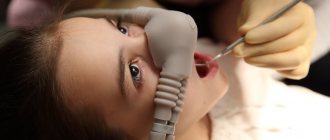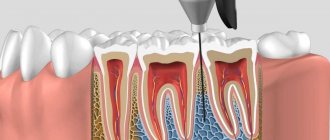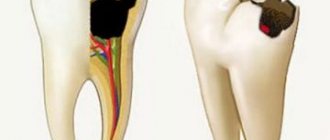For many years, dental treatment was accompanied by pain or discomfort. All this contributed to the development of a great fear of going to the dental office. People have become so afraid of doctors that they are ready to risk their health by testing dubious traditional methods on themselves just to avoid going to an appointment.
Pain and discomfort can be completely eliminated with the help of anesthesia; it is usually used when pain cannot be tolerated. But the injection or drip itself is not very pleasant, and it takes a long time to recover from anesthesia.
Therefore, local anesthesia has become the most common method of relieving pain during a session. The method of pain relief and the drug itself are constantly being improved, and this allows dentists to keep control over the patient’s sensation and condition and select an effective remedy individually for each person.
What determines the level of pain during dental treatment?
If the word “treatment” means not only the common procedure of filling teeth, then not all doctor’s manipulations in the oral cavity cause pain. For example, here is a list of completely painless procedures:
- Treatment of shallow caries.
- Whitening tooth enamel.
- Professional teeth cleaning with AirFlow.
- Deep fluoridation of teeth.
- Fissure sealing.
Most of the above procedures are preventive. Thus, it becomes clear that if you visit the dentist solely to prevent disease, there will be no need for painful procedures.
In other cases, the appearance and degree of pain will depend on the following factors:
- Individual sensitivity and pain threshold of the patient.
- The degree of tooth damage.
- The presence of inflammation, including purulent.
- Individual features of anatomy (location of the nerve ending close to the surface of the tooth, etc.).
- Susceptibility to anesthetic.
- Emotional mood before treatment.
Enamel is the least sensitive, but the more damaged it is, the more susceptible the tooth is to pain. Below the level of the gum, the neck of the tooth does not have enamel, it consists of “cement”; therefore, any dental manipulation in the lower part of the tooth will be accompanied by severe pain.
You should know that without anesthesia it is impossible to cure pulpitis in any form, since the area of its damage consists of nerve and vascular fibers.
Is it possible to have a painless injection?
Most patients, even when performing a simple filling, ask for an anesthetic injection to stop experiencing fear of sudden pain. But such an injection in itself is quite unpleasant. To reduce the pain from an injection, doctors use:
- Special carpule syringes with thin needles.
- Before the injection, the mucous part is dried with a dental hair dryer so that penetration is painless.
- The injection site is treated with anesthetic ointment or gel.
- The medicine is administered very slowly, so after the first dose is administered, the patient will not feel the second.
What determines the choice of filling?
Fillings are divided into temporary and permanent. Temporary fillings are also called diagnostic fillings. They are used to identify symptoms that will define the disease.
If not only the tooth structure is damaged, but also deeper layers, then a temporary filling helps diagnose the disease.
A permanent filling is used for completely different purposes and its quality is significantly different from a temporary one. The purpose of a permanent filling is to hermetically seal the tooth opening and for aesthetic purposes.
Fillings can be made of different materials, depending on the purpose. There are fillings: cement-based, plastic, amalgam, ceramic, etc. The dentist will determine which filling is right for you during a consultation.
Types of anesthesia
Methods and painkillers differ significantly in the mechanism of action and the method of administration into the body. The following types of anesthesia are used in the field of therapeutic dentistry:
- Application – involves applying a special gel or spray based on an antiseptic. It is used at the site of an anesthetic injection, removal of dental plaque and when removing baby teeth.
- Infiltration - introducing a dose of anesthetic into the gum tissue by injection. With this injection, the nerve endings are completely blocked. The teeth and adjacent tissues completely lose their sensitivity. Under such anesthesia, it is possible to treat almost any dental disease and even perform minor operations.
- Conduction - this type of anesthesia involves delivering the drug directly to the branch of the trigeminal dental nerve, which blocks the transmission of impulses along the entire length of the nerve. This method is used in areas of dense bone formations of the lower jaw, because it is impossible to administer a direct injection into this area due to the insufficient width of the open mouth. The technique of performing conduction anesthesia is quite complex, and in itself can be painful, but it provides the longest and most lasting effect in the treatment of the lower and upper jaw.
Pain during dental treatment
What determines the occurrence of pain:
- On the patient's degree of susceptibility;
- Neglect of the problem;
- The presence of purulent inflammation;
- Depth of tooth damage;
- Location of roots and lateral branches;
- Whether the patient took alcohol and painkillers before visiting the doctor.
Enamel is the least sensitive. Its destruction increases the tooth's susceptibility to pain. There is no enamel below the gum level, so the discomfort is pronounced. It is impossible to treat the pulp without anesthesia, since this tissue is penetrated by nerve fibers.
Treatment with laser
The laser has found its use in many industries, but it is especially popular in medicine. Initially, the laser was used for operations as a replacement for a surgical scalpel. Now modern clinics use it for dental treatment. The laser works completely painlessly, and is actively used in the treatment of canals and root cysts, gum problems, and diseases of the mucous membrane.
A typical laser therapy session looks like this:
- The dentist conducts a detailed scan of each tooth for caries, using a laser to identify even damaged areas on the tooth surface that are invisible to the eye.
- The identified problem areas are then treated, with the beam targeting only the caries-affected areas with surgical precision, providing antibacterial cleaning to healthy teeth to prevent accidental infection of a healthy tooth.
- Next, the tooth is washed, treated with an adhesive system and sealed with high quality cement mortar, the composition of which is similar to the composition of a real tooth.
Treatment of dental canals without pain is carried out according to a standard protocol, and a laser beam is used for thorough cleaning of the canals and their antiseptic treatment. Under the action of a dental laser, all liquid instantly evaporates, thus the canals are completely cleaned of pulp, bacteria and other inorganic particles that got on the tooth during the procedure.
Benefits of laser dental treatment:
- Complete absence of pain, discomfort and fear during treatment.
- There is no need to wait until the painkillers take effect.
- The laser treatment procedure is many times faster than treatment with the classical method.
- Gentle treatment of the tooth surface.
- Complete elimination of the possibility of secondary caries
- Prevention of bleeding during treatment in the gingival cavities.
- Complete cleaning of dental canals and no complications
Flaws:
- Only superficial and medium caries can be treated with laser
- High cost of treatment due to the high cost of equipment.
- Physicians must have appropriate qualifications in handling such a device.
Why treat baby teeth?
Even a seemingly insignificant spot can cause the development of caries, pulpitis and spread to neighboring teeth. All this can provoke attacks of acute pain.
Pain and discomfort in the presence of dental pathologies lead to the fact that the child begins to avoid unpleasant sensations - chewing on only one side of the jaw. This can create an incorrect bite.
Diseases of primary teeth negatively affect the rudiments of molars. In this case, permanent teeth grow with defects and will need to be constantly treated.
Types and stages of general anesthesia
General anesthesia is a procedure that involves the use of narcotic substances to put the patient into a state of sleep. There are several methods of administering the drug:
- Inhalation (through the use of gaseous substances);
- Intravenous (an anesthetic (or a mixture of drugs) is introduced into the human body by injection).
Both methods are actively used in modern dentistry.
Inhalation anesthesia takes place according to the following algorithm: the patient is placed on the dental chair. They give you a gas mask and ask you to breathe for 1-2 minutes. First, ordinary pure oxygen is supplied to the mask, and then, starting with a minimum concentration, a narcotic mixture is introduced. If necessary, the dose is increased. Afterwards, the oral mask is removed and a nasal mask is put on.
Thus, the introduction of anesthesia goes through four stages: introduction, analgesia (duration 3-4 minutes), excitement (7 minutes), maintenance. The decrease in the narcotic substance in the body occurs gradually. At the final stage, the patient is allowed to breathe oxygen for 2-3 minutes.
Full recovery after general inhalation anesthesia occurs in 30-40 minutes.
Indications for consultation with a dentist-therapist
To keep your teeth healthy and beautiful until old age, you need to monitor the condition of your teeth and consult a dentist at the first symptoms. For preventive maintenance, people visit the dentist 2 times a year; this approach will help avoid caries and prevent dental problems.
- Advanced diagnostic techniques. NKClinic uses only the most modern devices that allow you to determine the problem with maximum accuracy in order to choose the optimal treatment regimen and save your time. For example, to determine the length of the canal and the phase of the pathological process, an apex locator is used - a high-precision endodontic device.
- Attention to detail. Our professionals strive for excellence in every aspect of dental caries treatment. For example, canal treatment is performed using Ni-Ti instruments, which guarantee complete removal of bacteria. The oral mucosa is protected from the effects of anesthetics using a rubber dam - a latex plate. To prevent re-infection, a hermetic three-dimensional filling is used.
- Comfort at all stages of treatment. We offer our clients: high-quality anesthesia, a cozy environment and entertainment (cinema, music, audiobooks) that will help you relax and avoid unpleasant sensations. The dentist's instruments are hidden from the patient's view to avoid additional stress.
- Expert level treatment. The doctors of our clinic are our pride! All dentists have an excellent education and internships in prestigious educational institutions. Also, NKClinic doctors regularly participate in international scientific conferences. Specialists quickly master new technologies, for example, dental treatment under a microscope, and even create them themselves, registering patents. Many years of practice guarantees flawless execution of even complex manipulations.
Technology and materials
Dental treatment using the icon system has a number of features. These include the following:
- The procedure will be effective only when treating caries at the spot stage, that is, when there is no superficial damage to the enamel.
- Anesthesia is not required, since a drill or other mechanical methods of treating the tooth are not used.
- Without a drill.
- Strengthening the structure of teeth and protecting it from negative environmental factors.
- Infiltration – does not lead to the appearance of microcracks. This ensures minimal risks for re-injury.
- Preservation of the natural shade and naturalness of the dental unit in comparison with the rest of the dentition.
Using the icon method allows you to treat caries without preliminary preparation. A number of drugs and materials are used to carry out the procedure:
- A special gel containing hydrochloric acid.
- Ethanol.
- Composite materials that harden under light rays.
Several options for infiltration kits are available. The first is for treating areas in close proximity to the mucous membrane. The second, for use in areas located in close proximity to adjacent healthy teeth.
Treatment of caries without preparation using the icon system allows you to get beautiful, smooth, transparent and healthy enamel. The action of the compositions begins immediately after application. Without affecting the tooth tissue, the solution penetrates directly into the damaged cavity. A qualified specialist is the key to the success and effectiveness of the procedure. The cost of icon caries treatment will depend on the patient’s clinical picture. However, the cost will be in the range of 4000-6000 rubles.
Complaints about the presence of a carious cavity and pain in sweets
Before
Stage
After
Specialists:
Kosichkina Olga Viktorovna
Patient G., 18 years old, came to our clinic with complaints of the presence of a carious cavity and pain in sweets, during the examination a carious cavity was discovered on tooth 4.6, during treatment under infiltration anesthesia, preparation of tooth 4.6 was carried out, drug treatment of the carious cavity followed by restoration of lost tooth tissue using fissure paints to create a more natural result. Finishing processing.
Treatment of caries using the icon method: indications and contraindications for use
Among the main indications for the use of this technique are the following:
- Removing the bracket system. It happens that wearing orthodontic appliances can lead to the formation of chalky spots in the cervical area. Treatment using the icon system can stop the further development of the disease, and also preserve the integrity of the tooth.
- The initial stage of caries (spot). This period is most favorable for curing dental units without damaging the surface, preserving the color and healthy condition of the enamel.
- Damage to teeth in hard-to-reach or hidden areas. In cases where access to the damaged area is difficult for a drill, for example in the spaces between teeth, using applicators with a special composition is the best way to achieve the desired result.
- The patient is young. Treatment of caries using the icon infiltration method will allow you to painlessly stop the destruction of baby teeth and not instill fear in the dentist’s office. And this is extremely important in childhood. In addition, the technique is absolutely safe and will not harm the baby.
Despite such a large number of advantages, the system is not without some disadvantages. Among the contraindications to treating caries without a drill with the icon system are the following factors:
- Advanced stage of caries.
- Children under 3 years old.
Advantages of SM-Dentistry
- Qualified pediatric dentists Specialists have extensive experience working with children and are well versed in child psychology. They know how to conduct treatment in a playful way. Our little patients love visiting dentists, are happy to come for preventive examinations and understand their importance.
- Comprehensive services The center’s dentists monitor the condition of the jaw apparatus of small patients from the moment the first tooth appears. They take into account all the anatomical features of the child and select the optimal treatment option. Doctors teach the child and parents how to properly perform oral hygiene.
- High-quality materials We use exclusively certified materials and medicines from world-famous manufacturers. We use only anesthetics that are safe for children. The clinic is equipped with the most modern equipment for the diagnosis and treatment of dental diseases.
You can find out more details and sign up for a consultation with a specialist by calling: +7
, or by filling out the form:
Purpose of general anesthesia in dentistry
General anesthesia is a rather complex and highly responsible intervention in the human body, and therefore requires fundamental knowledge and experience of a highly qualified specialist, modern technical and drug support, as well as appropriate hospital conditions.
All dental clinics that plan to conduct any types of treatment under anesthesia must have a license to provide these services. Ideally, general anesthesia should only be used in a hospital setting, with an intensive care unit or ward available in case of any complications.
The task of the anesthesiologist is to provide the following conditions to the patient:
- analgesia;
- amnesia;
- neurovegetative protection;
- the most convenient conditions for performing dental procedures that are invasive and traumatic.
The anesthesiologist's first priority is always maximum patient safety, avoiding complications and preventing the consequences of anesthesia. It should be remembered that general anesthesia is always associated with a certain percentage of risk, although in modern practice it is extremely small.
Complications after general anesthesia –
Modern drugs for putting the patient to sleep, as well as the most modern anesthesiological equipment that allows monitoring heart function and blood pressure, allow us to assert that anesthesia is now as safe as local anesthesia. At least statistics show the same frequency of complications with these types of pain relief. We have already said that in dentistry, sedation is used much more often than anesthesia. Moreover, there is no mortality from sedation at all.
After completing sedation, patients become fully functional within a very short period of time. In this regard, full-fledged intravenous and inhalation anesthesia, of course, has a large number of side effects and complications. Complications during anesthesia are cardiac arrest (as a result of an overdose of an anesthetic drug or diseases of the cardiovascular system), respiratory depression and arrest, as well as vomiting.
But these complications are extremely rare, because Nowadays, modern equipment for monitoring the patient’s condition is almost universally used, allowing an adequate and rapid response to changes in the patient’s condition. In addition, after recovery from anesthesia, dizziness, development of phlebitis and thrombophlebitis, decreased blood pressure, decreased heart rate, hallucinations, neuromuscular excitation, nausea and vomiting may be observed. We hope that our article on the topic: Treatment and extraction of teeth under general anesthesia was useful to you!
Sources:
1. Dental education of the author of the article, 2. Based on personal experience as a dentist, 3. National Library of Medicine (USA), 4. “General anesthesia and sedation in pediatric dentistry” (Stosh V.), 5. “Dental care for young children under general anesthesia” (Kiselnikova L.P.).
Complaints about aesthetic defects of central teeth
Before
Stage
After
Specialist:
Zakharova Daria Mikhailovna
Patient G., 28 years old, came to the clinic with complaints of an aesthetic defect in the central teeth. Previously, treatment was carried out using a brace system in our clinic. During the examination, the presence of old fillings on 1.1, 2.1 was discovered, the marginal fit was broken, there was a secondary carious process under the fillings, there were no contact points between the teeth. 2.1 tooth was depulped, resulting in darkening of the tooth tissue.
The treatment was carried out under infiltration anesthesia, during which old fillings were removed, carious cavities were prepared, cavities were treated with medication, followed by restoration and restoration of the anatomical shape using paints (to simulate fluorosis) of teeth 1.1,2.1, finishing treatment.
Presence of carious cavity and pain for sweets
Before
Stage
After
Specialist:
Chernenkaya Evgenia Vladimirovna
Patient Ch., 30 years old, came to our clinic with complaints of the presence of a carious cavity and pain in sweets. During the examination, a carious cavity was discovered on tooth 3.7. During treatment, tooth 3.7 was prepared under infiltration anesthesia, drug treatment of the carious cavity followed by restoration of lost tooth tissue using fissure paints to create a more natural result. Finishing processing.










